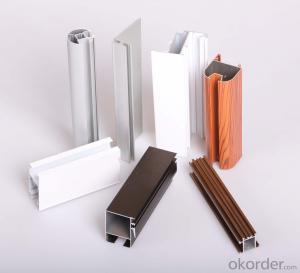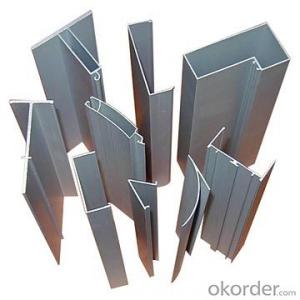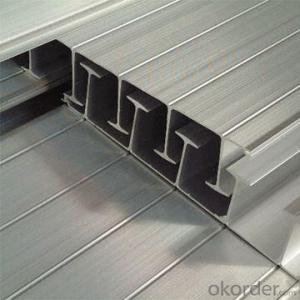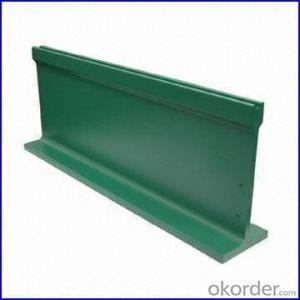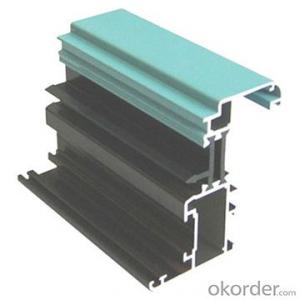alu perfiles for window and door
- Loading Port:
- China Main Port
- Payment Terms:
- TT OR LC
- Min Order Qty:
- -
- Supply Capability:
- -
OKorder Service Pledge
OKorder Financial Service
You Might Also Like
Aluminium is a relatively soft, durable, lightweight, ductileand malleablemetalwith appearance ranging from silvery to dull gray, depending on the surfaceroughness. It is nonmagnetic and does not easily ignite. A fresh film ofaluminium serves as a good reflector (approximately 92%) of visible lightand an excellent reflector (as much as 98%) of medium and far infraredradiation. The yield strength of pure aluminium is 7–11 MPa,while aluminium alloys have yield strengths ranging from200 MPa to 600 MPa. Aluminium has about one-third the densityand stiffness of steel. It is easily machined,cast, drawn and extruded.
Features:
Material | Alloy 6063,6061,6005or according to customer’s choice |
Temper | T3, T4, T5, T6 |
Surface | Anodize, electrophoresis, powder coating, PVDF coating, wood grain painting, matted, etc. |
Length | Coating 6.5 meters, Anodizing 6.5 meters, Mill finish 5 meters |
Application | Industrial, electrical equipment(TV set, air conditioner, refrigerator, computer), decoration,construction, transportation |
Custom Made | We can package following with customer's request. |
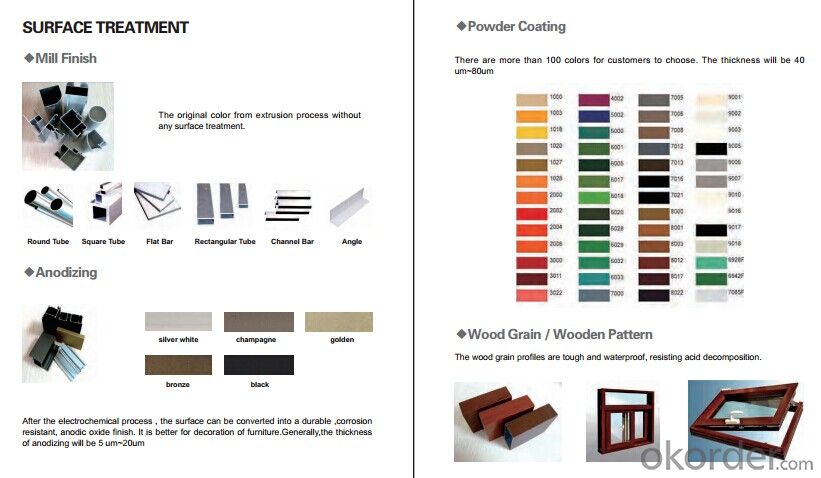

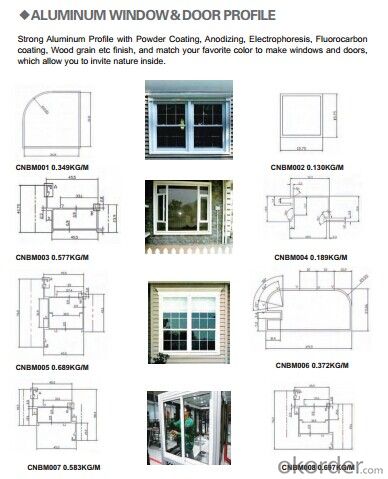
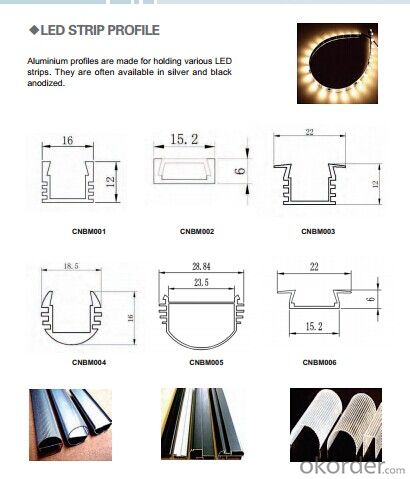
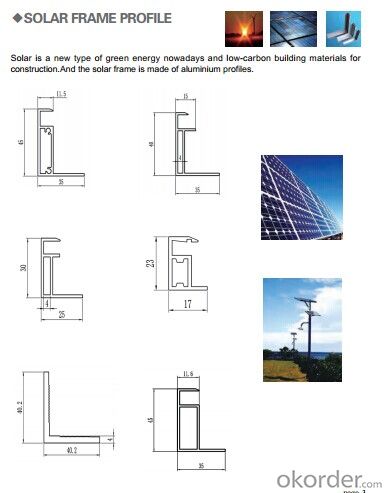
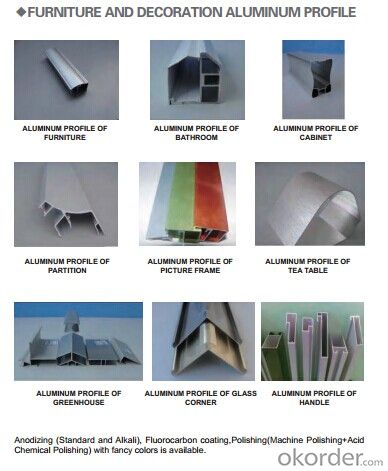
- Q:How do aluminum profiles contribute to the reduction of carbon footprint?
- Due to their environmental benefits, aluminum profiles play a crucial role in reducing carbon footprints. To begin with, aluminum is a highly recyclable material, with nearly 75% of all aluminum ever produced still in use today. This recyclability greatly diminishes the necessity for extracting and refining new aluminum, which is an energy-intensive process that contributes to carbon emissions. Furthermore, the lightweight characteristic of aluminum profiles offers numerous advantages in terms of transportation and energy consumption. In comparison to materials like steel, aluminum is significantly lighter, resulting in reduced fuel consumption during transportation. This not only decreases carbon emissions but also lowers the overall energy required for logistics. Moreover, aluminum profiles are widely utilized in the construction industry, where they make a significant contribution to the energy efficiency of buildings. Aluminum's exceptional thermal conductivity allows for the creation of highly efficient windows, doors, and facades, which prevent heat transfer and reduce the need for excessive heating or cooling. By enhancing the energy efficiency of buildings, aluminum profiles aid in minimizing energy consumption and subsequently decreasing carbon emissions. Additionally, aluminum profiles have a long lifespan and require minimal maintenance, reducing the need for frequent replacement. This durability helps conserve resources and lowers the carbon emissions associated with the production and disposal of alternative materials. All in all, the utilization of aluminum profiles in various industries significantly contributes to the reduction of carbon footprints. Its recyclability, lightweight nature, energy efficiency, and durability all make aluminum a sustainable choice with a positive impact on the environment.
- Q:What materials are used for aluminum profile packing?
- if the surface requirements is not high, three point type packaging is also common, some products need to add pearl carton / wooden packaging. Shanghai aluminum products Co., Ltd.
- Q:Can aluminum profiles be cut to size?
- Yes, aluminum profiles can be cut to size. Aluminum profiles are typically manufactured in standard lengths and can be easily cut to the desired length or size using various cutting methods such as sawing, shearing, or CNC machining. This allows for customization and flexibility in using aluminum profiles for different applications.
- Q:What are the thermal properties of aluminum profiles?
- Due to its inherent characteristics as a metal, aluminum profiles possess favorable thermal properties. With its high thermal conductivity, aluminum can efficiently transfer heat, making it an ideal choice for applications requiring heat dissipation or thermal management. Furthermore, aluminum profiles exhibit minimal expansion and contraction with temperature changes due to their low coefficient of thermal expansion. This exceptional stability and resistance to warping or distortion, even in extreme temperature variations, make aluminum profiles highly reliable. In addition, aluminum profiles have a comparatively low melting point, making them suitable for applications involving high operating temperatures. The ability of aluminum to withstand such temperatures without compromising its structural integrity further enhances its thermal properties. Moreover, aluminum profiles demonstrate excellent thermal insulation properties as they are not easily conductive of heat. This makes them a suitable choice for applications requiring thermal insulation or the prevention of heat transfer, such as in building and construction or HVAC systems. In summary, the thermal properties of aluminum profiles, including high thermal conductivity, low coefficient of thermal expansion, high melting point, and good thermal insulation, contribute to their versatility and widespread use across various industries, ranging from automotive and aerospace to electronics and construction.
- Q:What are the advantages of using aluminum profiles in window and door frames?
- Using aluminum profiles in window and door frames comes with several benefits. To begin with, aluminum is a lightweight material, making it easier to handle during installation and maintenance. This simplifies the overall construction process and reduces costs. In addition, aluminum is highly durable and resistant to corrosion, ensuring that window and door frames have a longer lifespan. Unlike materials like wood or steel, aluminum does not rot, warp, or rust when exposed to moisture or extreme weather conditions. This durability leads to lower maintenance and replacement expenses over time. Moreover, aluminum profiles provide excellent thermal insulation properties. They can be designed with thermal breaks or insulating materials, effectively preventing heat or cold transfer between the interior and exterior of a building. As a result, energy efficiency is improved and heating and cooling costs are reduced. Furthermore, aluminum profiles can be easily customized to meet various design requirements. They are available in a wide range of shapes, sizes, and finishes, offering flexibility in architectural designs. Whether it's a modern or traditional style, aluminum profiles can be tailored to meet specific aesthetic preferences. Additionally, aluminum is a sustainable and environmentally friendly material. It is 100% recyclable without losing its properties, making it an ideal choice for those concerned about reducing their carbon footprint. Lastly, aluminum profiles offer enhanced security features. They can be reinforced with additional locking mechanisms and impact-resistant glass, providing better protection against break-ins and ensuring the safety of occupants. In conclusion, the advantages of using aluminum profiles in window and door frames include their lightweight nature, durability, thermal insulation properties, customization options, sustainability, and enhanced security features. Opting for aluminum profiles can result in long-term cost savings, energy efficiency, and aesthetic appeal for any building project.
- Q:How do aluminum profiles perform in vibration and shock absorption applications?
- Aluminum profiles are widely used in vibration and shock absorption applications due to their excellent performance characteristics. The high strength-to-weight ratio of aluminum makes it an ideal material for such applications, as it can effectively absorb and dampen vibrations and shocks. One of the key advantages of aluminum profiles in vibration and shock absorption applications is their ability to dissipate energy. Aluminum has a natural ability to absorb and distribute energy, which helps in reducing the impact of vibrations and shocks. This is particularly beneficial in industries such as automotive, aerospace, and construction, where the safety and performance of equipment, structures, and components are paramount. Moreover, aluminum profiles can be designed and engineered to have specific properties that enhance their vibration and shock absorption capabilities. For instance, different alloy compositions, shapes, and cross-sections can be utilized to optimize the material's resilience and damping characteristics. This allows for tailoring the profiles to meet the specific requirements of different applications. Another advantage of aluminum profiles in vibration and shock absorption applications is their corrosion resistance. Aluminum naturally forms a protective oxide layer on its surface, which prevents it from corroding. This makes aluminum profiles highly durable and suitable for use in harsh environments where corrosion can be a major concern, such as marine applications. Furthermore, aluminum profiles are easy to fabricate and install, which adds to their appeal in vibration and shock absorption applications. Their lightweight nature simplifies handling and reduces the overall weight of the system, while their flexibility allows for easy integration into various designs. In conclusion, aluminum profiles demonstrate excellent performance in vibration and shock absorption applications. Their high strength-to-weight ratio, energy dissipation capabilities, corrosion resistance, and ease of fabrication make them a preferred choice for industries that require effective dampening of vibrations and shocks.
- Q:What is the difference between 6061-T6 and 6063-T6 in aluminum profile?
- Alloy composition is different, 6061 of the other alloy composition is much higher than 6063.
- Q:How do aluminum profiles perform in wind-resistant structures?
- Aluminum profiles perform exceptionally well in wind-resistant structures due to their inherent strength and durability. The lightweight nature of aluminum makes it an ideal material for constructing structures that need to withstand high wind loads. Additionally, aluminum exhibits excellent corrosion resistance, ensuring its longevity in outdoor environments. Its flexibility allows for creative and efficient design solutions, while its high stiffness-to-weight ratio provides structural integrity. Overall, aluminum profiles offer superior performance in wind-resistant structures.
- Q:What are the differences between horizontal and vertical aluminum profiles?
- Horizontal vertical hanger in the middle on the head,Therefore, the horizontal number will affect the surface a little, and when you have to find non decorative surface hangingThe vertical head is better, a hanging point, just cut off
- Q:What's the difference between aluminum oxide and electrophoresis?
- Main features: 1 aluminum oxide) has strong abrasion resistance, weatherability and corrosion resistance. 2) can form a variety of colors on the surface of the substrate, the maximum for your requirements. 3) hardness, making it suitable for all kinds of buildings, industrial materials.Main features: 1 electrophoresis aluminum) has strong film hardness and strong impact resistance. 2) has very high adhesion of film, aging is not easy to fall off. 3) has better wear resistance, weather resistance and alkali resistance than aluminum oxide. 4) surface color is rich, beautiful, with a mirror like luster effect.Aluminum electrophoresis processing in oxidized aluminum on the basis of better quality than the oxidized aluminum chip. The price is a little better.
1. Manufacturer Overview |
|
|---|---|
| Location | |
| Year Established | |
| Annual Output Value | |
| Main Markets | |
| Company Certifications | |
2. Manufacturer Certificates |
|
|---|---|
| a) Certification Name | |
| Range | |
| Reference | |
| Validity Period | |
3. Manufacturer Capability |
|
|---|---|
| a)Trade Capacity | |
| Nearest Port | |
| Export Percentage | |
| No.of Employees in Trade Department | |
| Language Spoken: | |
| b)Factory Information | |
| Factory Size: | |
| No. of Production Lines | |
| Contract Manufacturing | |
| Product Price Range | |
Send your message to us
alu perfiles for window and door
- Loading Port:
- China Main Port
- Payment Terms:
- TT OR LC
- Min Order Qty:
- -
- Supply Capability:
- -
OKorder Service Pledge
OKorder Financial Service
Similar products
New products
Hot products
Related keywords
